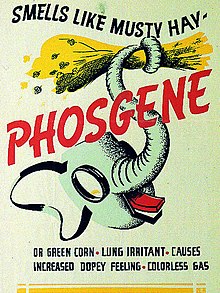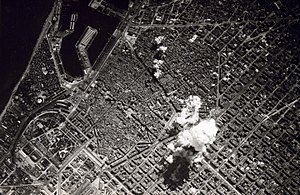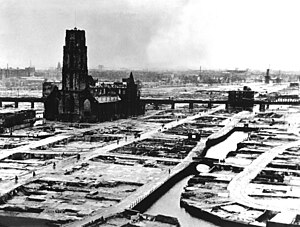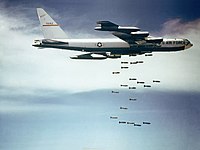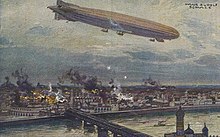|
| |||

| |||
| Names | |||
|---|---|---|---|
| Preferred IUPAC name
Carbonyl dichloride | |||
| Other names
Carbonyl chloride
CG Carbon dichloride oxide Carbon oxychloride Chloroformyl chloride Dichloroformaldehyde Dichloromethanone Dichloromethanal | |||
| Identifiers | |||
3D model (JSmol)
|
|||
| ChEBI | |||
| ChemSpider | |||
| ECHA InfoCard | 100.000.792 | ||
| EC Number |
| ||
PubChem CID
|
|||
| RTECS number |
| ||
| UNII | |||
| UN number | 1076 | ||
CompTox Dashboard (EPA)
|
|||
| Properties | |||
| COCl2, also CCl2O | |||
| Molar mass | 98.92 g/mol | ||
| Appearance | Colorless gas | ||
| Odor | Suffocating, like musty hay | ||
| Density | 4.248 g/L (15 °C, gas) 1.432 g/cm3 (0 °C, liquid) | ||
| Melting point | −118 °C (−180 °F; 155 K) | ||
| Boiling point | 8.3 °C (46.9 °F; 281.4 K) | ||
| Insoluble, reacts | |||
| Solubility | Soluble in benzene, toluene, acetic acid Decomposes in alcohol and acid | ||
| Vapor pressure | 1.6 atm (20°C) | ||
| −48·10−6 cm3/mol | |||
| Structure | |||
| Planar, trigonal | |||
| 1.17 D | |||
| Hazards | |||
| Safety data sheet | ICSC 0007 | ||
EU classification (DSD) (outdated)
|
|||
| R-phrases (outdated) | R26 R34 | ||
| S-phrases (outdated) | (S1/2) S9 S26 S36/37/39 S45 | ||
| NFPA 704 (fire diamond) | |||
| Flash point | Non-flammable | ||
Threshold limit value (TLV)
|
0.1 ppm | ||
| Lethal dose or concentration (LD, LC): | |||
LC50 (median concentration)
|
500 ppm (human, 1 min) 340 ppm (rat, 30 min) 438 ppm (mouse, 30 min) 243 ppm (rabbit, 30 min) 316 ppm (guinea pig, 30 min) 1022 ppm (dog, 20 min) 145 ppm (monkey, 1 min) | ||
LCLo (lowest published)
|
3 ppm (human, 2.83 h) 30 ppm (human, 17 min) 50 ppm (mammal, 5 min) 88 ppm (human, 30 min) 46 ppm (cat, 15 min) 50 ppm (human, 5 min) 2.7 ppm (mammal, 30 min) | ||
| NIOSH (US health exposure limits): | |||
PEL (Permissible)
|
TWA 0.1 ppm (0.4 mg/m3) | ||
REL (Recommended)
|
TWA 0.1 ppm (0.4 mg/m3) C 0.2 ppm (0.8 mg/m3) [15-minute] | ||
IDLH (Immediate danger)
|
2 ppm | ||
| Related compounds | |||
Related compounds
|
Thiophosgene Formaldehyde Carbonic acid Urea Carbon monoxide Chloroformic acid | ||
Except where otherwise noted, data are given for materials in their standard state (at 25 °C [77 °F], 100 kPa). | |||
| Infobox references | |||
|
|
| ||
Phosgene is the organic chemical compound with the formula COCl2. It is a colorless gas; in low concentrations, its odor resembles that of freshly cut hay or grass. Phosgene is a valued industrial building block, especially for the production of urethanes and polycarbonate plastics.
It is very poisonous and was used as a chemical weapon during World War I, when it was responsible for 85,000 deaths.
In addition to its industrial production, small amounts occur from the breakdown and the combustion of organochlorine compounds.
Structure and basic properties
Phosgene is a planar molecule as predicted by VSEPR theory. The C=O distance is 1.18 Å, the C−Cl distance is 1.74 Å and the Cl−C−Cl angle is 111.8°. It is one of the simplest acyl chlorides, being formally derived from carbonic acid.
Production
Industrially, phosgene is produced by passing purified carbon monoxide and chlorine gas through a bed of porous activated carbon, which serves as a catalyst:
- CO + Cl2 → COCl2 (ΔHrxn = −107.6 kJ/mol)
The reaction is exothermic, therefore the reactor must be cooled. Typically, the reaction is conducted between 50 and 150 °C. Above 200 °C, phosgene reverts to carbon monoxide and chlorine, Keq(300 K) = 0.05. World production of this compound was estimated to be 2.74 million tonnes in 1989.
Because of safety issues, phosgene is often produced and consumed within the same plant, and extraordinary measures are made to contain it. It is listed on Schedule 3 of the Chemical Weapons Convention: All production sites manufacturing more than 30 tonnes per year must be declared to the OPCW. Although less dangerous than many other chemical weapons such as sarin, phosgene is still regarded as a viable chemical warfare agent because it is so easy to manufacture when compared to the production requirements of more technically advanced chemical weapons such as the first-generation nerve agent tabun.
Inadvertent generation
Upon ultraviolet (UV) radiation in the presence of oxygen, chloroform slowly converts into phosgene by a radical reaction. To suppress this photodegradation, chloroform is often stored in brown-tinted glass containers and with a small percentage of ethanol added. Chlorinated solvents used to remove oil from metals, such as automotive brake cleaners, are converted to phosgene by the UV rays of arc welding processes.
Phosgene may also be produced during testing for leaks of older-style refrigerant gases.
Chloromethanes (R12, R22 and others) were formerly leak-tested in situ by employing a small gas torch (propane, butane, or propylene gas) with a sniffer tube and a copper reaction plate in the flame nozzle of the torch. If any refrigerant gas was leaking from a pipe or joint, the gas would be sucked into the flame through the sniffer tube and would cause a colour change of the gas flame to a bright greenish blue. In the process, phosgene gas would be created due to the thermal reaction. No valid statistics are available, but anecdotal reports suggest that numerous refrigeration technicians suffered the effects of phosgene poisoning due to their ignorance of the toxicity of phosgene, produced during such leak testing.
Electronic sensing of refrigerant gases phased out the use of flame testing for leaks in the 1980s. Similarly, phosgene poisoning is a possibility for people fighting fires that occur in the vicinity of refrigerant leaks from air-conditioning systems or refrigeration equipment, smoking in the vicinity of a freon refrigerant leak, or fighting fires using halon or halotron.
Phosgene can be released during building fires. In one instance, a deputy fire chief died ten days after inhaling fumes that wafted down outside a burning restaurant. After a two-day hospitalization he had appeared to recover, but ultimately suffered cardiac arrest at home following tracheobronchial inflammation, alveolar hemorrhage, and pulmonary edema. The phosgene was produced by decomposing Freon 22 after flames ducted up from a grease fire heated an air-conditioning unit on the roof and ruptured a hose.
History
Phosgene was synthesized by the Cornish chemist John Davy (1790–1868) in 1812 by exposing a mixture of carbon monoxide and chlorine to sunlight. He named it "phosgene" in reference of the use of light to promote the reaction; from Greek, phos (light) and gene (born). It gradually became important in the chemical industry as the 19th century progressed, particularly in dye manufacturing.
Reactions and uses
The great majority of phosgene is used in the production of isocyanates, the most important being toluene diisocyanate (TDI) and methylene diphenyl diisocyanate (MDI). These two isocyanates are precursors to polyurethanes. The reaction of an organic substrate with phosgene is called phosgenation.
Synthesis of carbonates
Significant amounts are also used in the production of polycarbonates by its reaction with bisphenol A. Polycarbonates are an important class of engineering thermoplastic found, for example, in lenses in eyeglasses. Diols react with phosgene to give either linear or cyclic carbonates (R = H, alkyl, aryl):
- HOCR2−X−CR2OH + COCl2 → 1⁄n [OCR2−X−CR2OC(O)−]n + 2 HCl
Phosgenation of hydroxamic acids gives dioxazolone, a class of cyclic carbonate esters:
- RC(O)NHOH + COCl2 → RC=NOCO2 + 2 HCl
Synthesis of isocyanates
The synthesis of isocyanates from amines illustrates the electrophilic character of this reagent and its use in introducing the equivalent of "CO2+":
Such reactions are conducted in the presence of a base such as pyridine that absorbs the hydrogen chloride.
Laboratory uses
In the research laboratory phosgene still finds limited use in organic synthesis. A variety of substitutes have been developed, notably trichloromethyl chloroformate ("diphosgene"), a liquid at room temperature, and bis(trichloromethyl) carbonate ("triphosgene"), a crystalline substance. Aside from the above reactions that are widely practiced industrially, phosgene is also used to produce acyl chlorides and carbon dioxide from carboxylic acids:
- RCO2H + COCl2 → RC(O)Cl + HCl + CO2
Such acid chlorides react with amines and alcohols to give, respectively, amides and esters, which are commonly used intermediates. Thionyl chloride is more commonly and more safely employed for this application. A specific application for phosgene is the production of chloroformic esters:
- ROH + COCl2 → ROC(O)Cl + HCl
Phosgene is stored in metal cylinders. The outlet is always standard, a tapered thread that is known as CGA 160
Other chemistry
Although it is somewhat hydrophobic, phosgene reacts with water to release hydrogen chloride and carbon dioxide:
- COCl2 + H2O → CO2 + 2 HCl
Analogously, with ammonia, one obtains urea:
- COCl2 + 4 NH3 → CO(NH2)2 + 2 NH4Cl
Halide exchange with nitrogen trifluoride and aluminium tribromide gives COF2 and COBr2, respectively.
Chemical warfare
The collapse of international conventions against chemical weapons led to the widespread use of chlorine gas in World War I, but its lethal concentration of 0.1% was visible as a green cloud in the air, allowing troops to take readily available countermeasures. Phosgene, colorless with a more subtle "moldy hay" odor, was introduced by a group of French chemists led by Victor Grignard and first used by the French in 1915. It was also used in a mixture with an equal volume of chlorine, with the chlorine helping to spread the denser phosgene. Phosgene was more potent than chlorine, though some of the symptoms of exposure took 24 hours or more to manifest, meaning the victims were initially still capable of putting up a fight.
Following the extensive use of phosgene gas in combat during World War I, it was stockpiled by various countries as part of their secret chemical weapons programs.
In May 1928, eleven tons of phosgene escaped from a war surplus store in central Hamburg. Three hundred people were poisoned, of whom 10 died.
Phosgene was then only infrequently used by the Imperial Japanese Army against the Chinese during the Second Sino-Japanese War. Gas weapons, such as phosgene, were produced by Unit 731 and authorized by specific orders given by Hirohito (Emperor Showa) himself, transmitted by the chief of staff of the army. For example, the Emperor authorized the use of toxic gas on 375 separate occasions during the Battle of Wuhan from August to October 1938.
Safety
Phosgene is an insidious poison as the odor may not be noticed and symptoms may be slow to appear.
The odor detection threshold for phosgene is 0.4 ppm, four times the threshold limit value. Its high toxicity arises from the action of the phosgene on the proteins in the pulmonary alveoli, the site of gas exchange: their damage disrupts the blood–air barrier, causing suffocation. It reacts with the amines of the proteins, causing crosslinking by formation of urea-like linkages, in accord with the reactions discussed above. Phosgene detection badges are worn by those at risk of exposure.
Sodium bicarbonate may be used to neutralise liquid spills of phosgene. Gaseous spills may be mitigated with ammonia.
Accidents
- On January 23, 2010, an accidental release of phosgene gas at a DuPont facility in West Virginia killed one employee.



